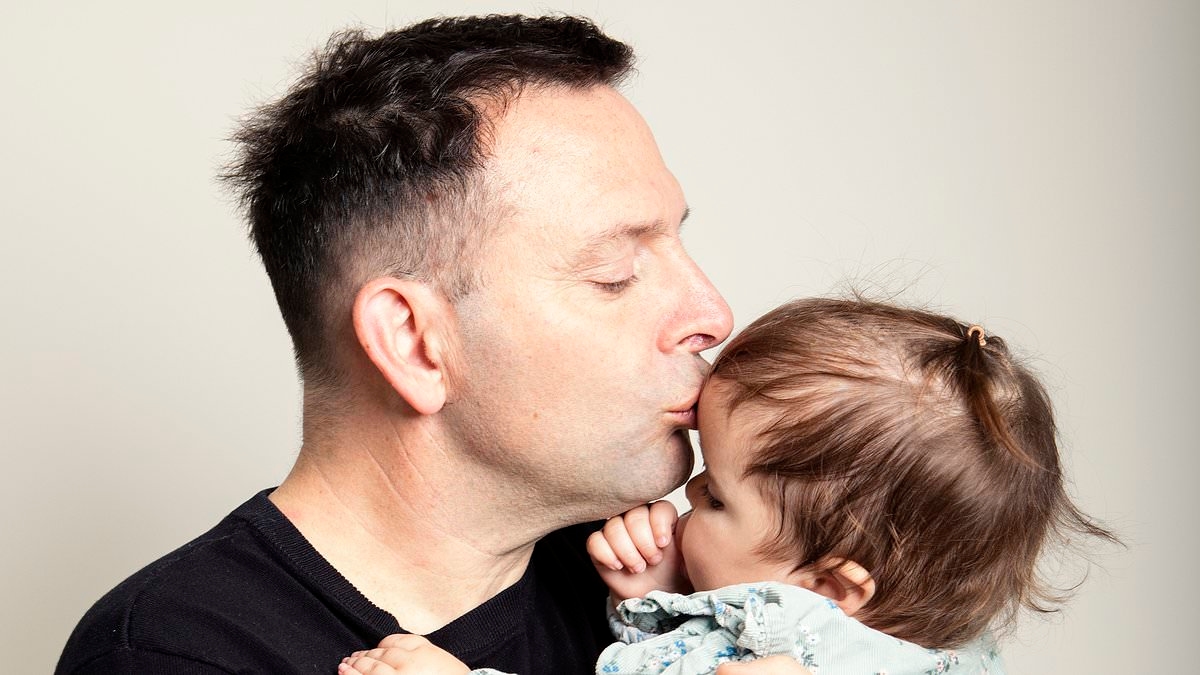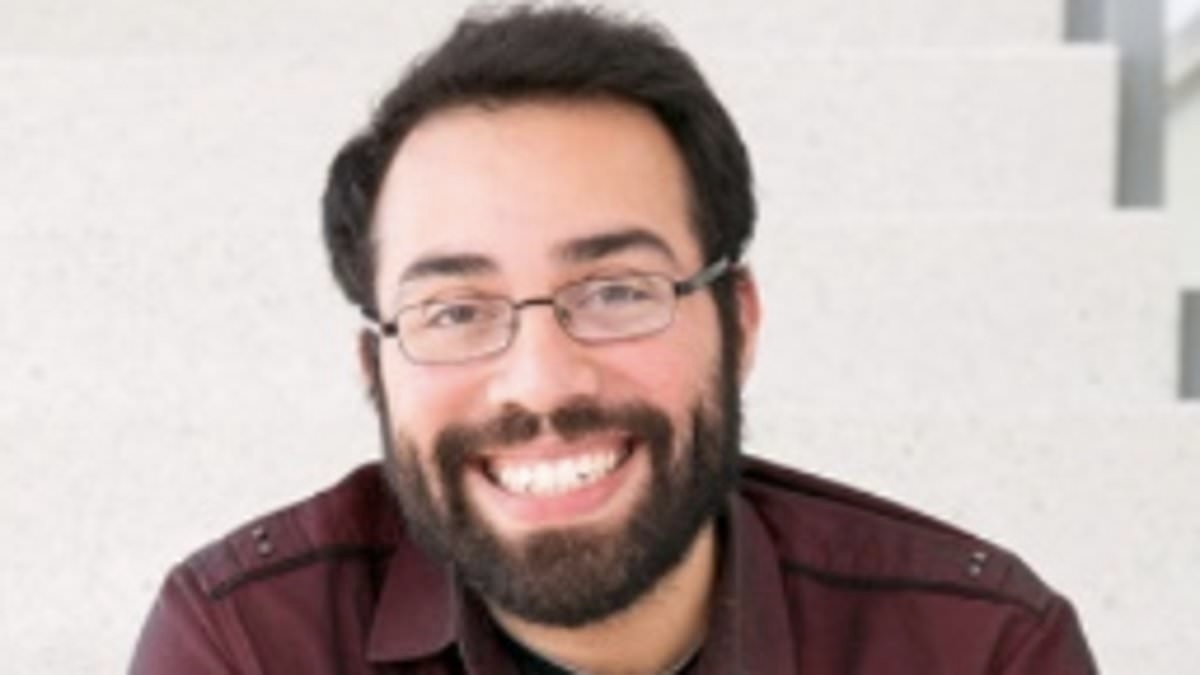Why I now fear my daughter's rare genetic condition is linked to me becoming a father later in life. This is the evidence you can't ignore: PROF ROB GALLOWAY

Published: | Updated:
Earlier this month, in the journal Nature, scientists from the Wellcome Sanger Institute in Cambridge published a study I can’t stop thinking about. It was to do with sperm – not the kind of subject that usually grabs my attention; but this one did, not so much for me as a doctor, but as a dad.
The researchers took sperm samples from men aged between 24 and 75, then analysed their DNA in astonishing detail, looking for potentially disease-creating mutations. What they found was both fascinating and heart-wrenching.
For years, we thought that as men got older, the risk of genetic problems in their children rose only slightly. This new research shows it’s higher than anyone had realised.
Just as we’ve known that increasing maternal age raises the risk of genetic conditions such as Down’s syndrome, this study showed that paternal age is just as significant.
This is because the stem cells in a man’s testes (which go on to become sperm) don’t just quietly grow old – they compete. Each is trying to produce the most sperm, and occasionally a mutation gives one an edge.
This mutated cell, by its very nature, divides faster, and over time its descendants start to take over. It’s evolution not across millennia, but happening within one man’s body.
The Cambridge researchers showed that at age 30, around one in 40 sperm carry a mutation that could cause disease. But by 70, that figure doubles to about one in 20.
A second study, published the very same day in Nature by scientists at Harvard University in the US, explored the same phenomenon from an entirely different angle (this wasn’t coincidence – the two papers were released in tandem to strengthen the evidence).
Professor Rob Galloway and his baby daughter Frankie who was born with a very rare genetic condition
The US researchers analysed genetic data from some of the world’s largest population databases, including deCODE Genetics in Iceland, the UK Biobank and major US and European genome projects.
These hold DNA from hundreds of thousands of people, including tens of thousands of families where both parents and their child have had their DNA mapped.
By comparing the child’s DNA with their parents’, the team could spot new mutations that had appeared spontaneously (rather than inherited mutations, such as having genes linked to cystic fibrosis).
This type of spontaneous mutation is almost always due to the father’s sperm – this is because, unlike eggs which are all made before birth, sperm are produced continuously throughout a man’s life, and every round of DNA copy-ing that goes into making a cell brings new chances for error.
When the researchers searched all the databases for these spontaneous mutations, the same handful of genes were seen again and again, but particularly in children of older fathers.
That doesn’t mean one in 20 children from an older father will be affected by a genetic condition. Many mutated sperm never reach an egg; embryos with serious mutations often fail to develop, or are lost very early in pregnancy.
And a large proportion of mutations occur in recessive genes – meaning that as long as the mother’s copy of that gene is healthy, the child will be a carrier but not affected.
Even in older fathers, the overall risk is small. New genetic conditions caused by spontaneous mutations occur in about one in 400 births, rising to one in 200 for dads aged 70.
That’s still rare for any one child – but significant across the population; every year in the UK, 2,000 children are born with a rare genetic condition caused by a spontaneous mutation.
As a doctor, this research has – overnight – changed how I think about ageing.
The testis isn’t a passive factory; it’s a living, evolving ecosystem – one that keeps producing sperm throughout life, and one that, as we now know, with every passing year, slowly lowers the odds of having a ‘normal’ child.
As a father, though, this research hit me on a different level. Because four months ago, when my daughter Francesca was one, she was diagnosed with a genetic condition so rare only 200 people in the whole world have it.
One letter out of the six billion that make up her genetic code is wrong. Just one – but that single letter has changed everything about the life I imagined for her.
Her condition is called DeSanto-Shinawi Syndrome, DESSH for short. It’s a neurodevelopmental disorder discovered less than ten years ago by Professor Marwan Shinawi in the US.
It’s caused by a fault in one copy of a gene called WAC – this gene provides the instructions to make a protein that helps cells grow, recycle and, in turn, regulate which genes are turned on and off in the brain.
When one copy is damaged, the body makes only about half the normal amount of the protein: the result is disrupted brain development, poor muscle tone, learning difficulties, autistic behaviours and sometimes epilepsy.
Each child’s genetic mutation is slightly different. Add to that the influence of their environment and other genes, and it explains why children with the same diagnosis can develop in such different ways.
Some with DESSH grow up facing major challenges with walking and talking, while others, with the right support and care for their learning difficulties and behavioural challenges, are able to attend school and live relatively normal lives.
However, because it’s so rare there are no treatments: for now, it’s only about therapy and support. At 17 months, Frankie (she’s ‘Frankie’ to us, though her older siblings insist on calling her Lou for reasons none of us can fathom) is behind her peers across all developmental domains.
She’s also very small for her age – more like a ten-month-old baby. For now, that means her disability isn’t always obvious to others. However, we know that as she grows, the gap with her peers will only become more and more noticeable.
But she fills our house with light. She blows kisses to everyone, claps perfectly in time to music, bobs her head to any rhythm, and laughs at everything her siblings do. She is pure joy.
At 17 months, Frankie (though her older siblings insist on calling her Lou for unknown reasons) is behind her peers across all developmental domains
As an A&E doctor, I’d convinced myself her developmental delays were just the after-effects of meningitis she’d had as a baby, and that she’d catch up.
In my head, I knew something wasn’t right; in my heart, I desperately wanted to believe she would be fine.
Then came the call from our paediatrician, followed by a two-page information sheet that changed everything. I remember staring at it, knowing that once I’d read it, life would be divided into before and after.
Her mum describes the feelings better than I ever could: relief that we finally had an answer, grief for the future we thought she’d have, guilt for feeling sad about a life we love so completely, and fear for what comes next.
People say that when your child is given a rare neurodevelopmental genetic diagnosis, you grieve.
And you do. Not for your child – because she is happy and doesn’t understand, but for the life you imagined. The milestones you thought certain – the first day at university, the walk down the aisle, the grandchildren – dissolve in a single moment.
Then there’s the fear that keeps you awake at night.
Her life expectancy may be shorter. I might outlive her – or she might outlive me, and I have to ask: who will care for her when I can’t?
But science is moving faster than I ever dreamed possible and it gives us hope.
And Frankie has already improved my life in ways I couldn’t have imagined.
While caring and playing with her, she’s taught me patience I didn’t know I had.
She’s shown me how to sit with uncertainty without letting it crush me. And she’s taught her siblings kindness, empathy and perspective.
And she’s made me realise that joy doesn’t come from milestones; it comes from moments – the first time she clapped on cue, or when she leaned in for a hug instead of arching away from me.
So yes, there’s sadness. But there’s also hope.
Yet the new research has made me think about time and chance. It’s also left me with a strange kind of guilt about whether my age played a part in causing this.
My eldest three children (who are in their pre-teens and older) are from a previous relationship and I was a month off 47 when Frankie was born. Should I have frozen my sperm when my wife and I first knew we wanted kids?
I think the message here, if there is one, is the fact that fertility problems and, as we now know, genetic risks for both women and men rise with age and therefore this should be part of the conversation for any couple starting to think about a family.
I will never know if it was my age that led to my daughter’s gene mutation.
But that’s irrelevant now, ultimately what really matters is my overwhelming love for her. Her name is Frankie. And she fills our lives with light.
Daily Mail





